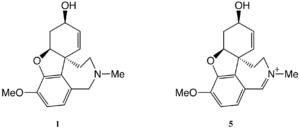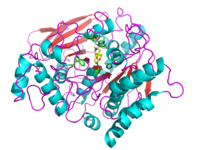COMPLEX OF TcAChE WITH AN IMINIUM GALANTHAMINE DERIVATIVE
(see also 1W4L, 1W76, and AChE inhibitors and substrates (Part III))
Biological Context
Alzheimer's disease is a disorder that attacks the central nervous system through progressive degeneration of its neurons. Patients with this disease develop dementia which becomes more severe as the disease progresses. It was suggested that symptoms of Alzheimer's disease are caused by a decrease in the activity of cholinergic neocortical and hippocampal neurons. Treatment for Alzheimer's disease by acetylcholine (ACh) precursors and cholinergic agonists was ineffective or caused side effects. The enzyme acetylcholinesterase (AChE) hydrolyses ACh, resulting in termination of cholinergic neurotransmission. Therefore, compounds which inhibit AChE might significantly increase the levels of ACh depleted by Alzheimer's disease. Galanthamine (1; GAL; Reminyl) is an AChE inhibitor and it is currently used for paliative therapy of Alzheimer's disease. The X-ray structure of Torpedo californica AChE (TcAChE) in complex with a galanthamine iminium derivative (5) was determined at 2.05 Å.
Publication Abstract from PubMed
Bifunctional derivatives of the alkaloid galanthamine, designed to interact with both the active site of the enzyme acetylcholinesterase (AChE) and its peripheral cation binding site, have been assayed with Torpedo californica AChE (TcAChE), and the three-dimensional structures of their complexes with the enzyme have been solved by X-ray crystallography. Differences were noted between the IC(50) values obtained for TcAChE and those for Electrophorus electricus AChE. These differences are ascribed to sequence differences in one or two residues lining the active-site gorge of the enzyme. The binding of one of the inhibitors disrupts the native conformation of one wall of the gorge, formed by the loop Trp279-Phe290. It is proposed that flexibility of this loop may permit the binding of inhibitors such as galanthamine, which are too bulky to penetrate the narrow neck of the gorge formed by Tyr121 and Phe330 as seen in the crystal structure.
The complex of a bivalent derivative of galanthamine with torpedo acetylcholinesterase displays drastic deformation of the active-site gorge: implications for structure-based drug design., Greenblatt HM, Guillou C, Guenard D, Argaman A, Botti S, Badet B, Thal C, Silman I, Sussman JL, J Am Chem Soc. 2004 Dec 1;126(47):15405-11. PMID:15563167
From MEDLINE®/PubMed®, a database of the U.S. National Library of Medicine.
-->

Structural Details
The binding mode of this (cyan) with TcAChE is virtually identical to that of galanthamine (red) itself (1dx6). The TcAChE residues of the galanthamine/TcAChE complex which interact with galanthamine are colored pink, while those of the compound 5/TcAChE complex are in lime. The main structural change is the side-chain movement of Phe330 in the compound 5/TcAChE complex, relative to its position in the of galanthamine/TcAChE complex. Compound 5 differs from galanthamine by the presence of the (N+; blue) instead of a tertiary amine in galanthamine . This chemical difference causes the structural change and the slight decrease in affinity of compound 5 to TcAChE in comparison to galanthamine itself.
About this Structure
1W6R is a Single protein structure of sequence from Torpedo californica. Full crystallographic information is available from OCA.
Additional Resources
For additional information, see: Alzheimer's Disease


